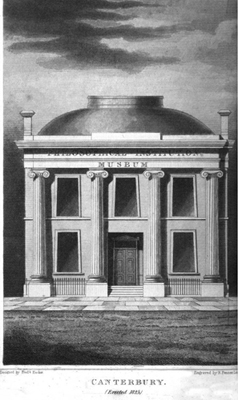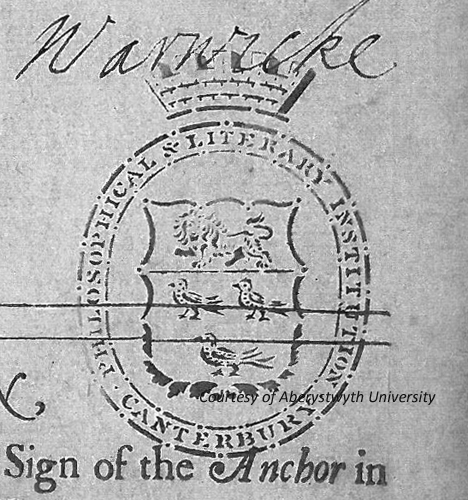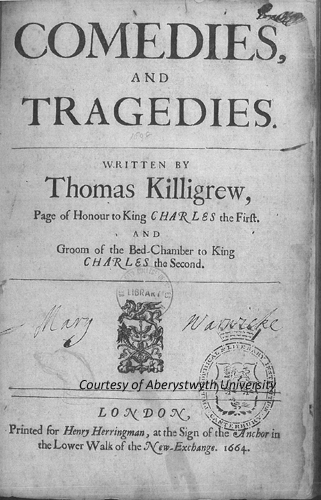
![]()
~ THE MUSEUM & FREE LIBRARY ~
The Philosophical and Literary Institution, erected 1825
GUILDHALL STREET, CANTERBURY
Moved to the Beaney Institute in 1898
If can can supply any other photos of the Philosophical & Literary Institution we would be grateful to receive them

Philosophical Institution and Museum, Guildhall Street, Erected 1825

Canterbury Philosophical & Literary Institution stamp printed on the book below. Thanks kindly to Aberystwyth University for the loan.

Subscriptions towards building to contain The Museum of Philosophical and Literary Institution "Canterbury City Council Meetings 1818-1828"
June 28th, The Mayor Osburn Snoulton Esqr laid the foundation stone of the Museum in Guildhall Street, 1825
Photo courtesy of Canterbury Heritage Museum, Stour Street, Canterbury
Annual Report of the Canterbury Philosophical and Literary Institution, presented at the Annual General Meeting, 25th September, 1827. Patrons. The Right Worshipful the Mayor of Canterbury, (for the time being) The Right Hon. the Earl of DARNLEY. The Right Hon. Lord SONDES. The Right Hon. Lord CLIFTON, M.P. Sir Edward KNATCHBULL, Bart., M.P. The Right Hon. S. R. LUSHINGTON, M.P. William Philip HONYWOOD, esq., M.P. Joseph ROYLE, Esq. Canterbury. Printed by MAWER COWTAN, King's Arms Library. (1826 Rules and Regulations printed by G. WOOD, Kent Herald Office, High Street, 1826)
The Philosophical Institution - This institution, situated in Guildhall Street, was established in 1825 by subscription. It consists of a Library of about 2200 volumes, an extensive Museum of natural and artificial curiosities, chiefly illustrative of Natural History, and a Lecture room capable of holding about a hundred persons in which lectures are delivered on Tuesday evenings at eight o'clock; the season commences in September and closes about May. The front is a handsome portico, consisting of four Ionic columns, and the windows are in the Egyptian style. 1838D
1838
Philosophical Institution & Museum, Guildhall Street
Secretary, T. WILKINSON, 23 Terrace
Treasurer, T. ATKINS, Dane John
Librarian, J. POUT, 6 High Street
Curator, William MASTERS, St. Peter's Street
Exhibitor, Collector, T. DAVEY, 11 High Street
Mr. John Brent. F.S.A. has published a handbook to the "Antiquities in the Canterbury Museum." The Architect and Contract Reporter Jan 1875
The Museum and Library was founded in 1826 and is open free from 10 a.m. to 10 p.m. The Library contains over 5,000 volumes, most of which are in circulation amongst the citizens; and there is a free Reading Room well supplied with newspapers.
The Museum contains many curiosities, and includes a collection of Roman antiquities, found in the city when the streets were being excavated for drainage, and a valuable oil painting by T. Sidney Cooper esq. R.A.
The Lusington Room contains the valuable animals, birds and weapons, bequeathed by the late S. R. Lushington esq.; and also a marble bust of the late Alderman Masters, by H. Weekes esq. R.A. 1882D
On the opposite side of the way, in the same street, stands the Philosophical and Literary Institution, erected in 1825, the front of which is ornamented with four columns, similar to those of the Ionic Temple on the river Ilisus at Athens. It has an exhibition room, 45 feet by 30, surmounted by a domical ceiling of ingenious construction, the height of which is 27 feet from the floor. On the top of the dome is a skylight, which throws an equal light over the room. There is a lecture room capable of containing 200 persons; and also a committee room library, and four convenient rooms on the basement floor. This elegant building was erected by the members of the institution, aided by a liberal subscription from the inhabitants of the city and neighbourhood, for the purpose of affording accommodation for the delivery of public lectures, the exhibition of a curious and extensive Museum, and for other objects connected with scientific and literary pursuits. WG
The Canterbury Philosophical and Literary Institution. - It is particularly gratifying to me to remark that the Institution, and more especially the Museum, are very flourishing, scarcely a week elapsing without some new additions. This week we have received a present of fifty birds, shot in the mountains near Madras, and presented by the governor, S. R. Lushington, Esq. Among them the wild fowl, cock and hen, the probable origin of our domestic brees, are very beautiful. W. Masters. St. Peter's Street, Canterbury, January 3, 1830
In Guildhall Street, which opens from the High Street, is the Museum, built by subscription, and containing some collections well worth a visit. Among the local antiquities is an A. S. drinking cup of "twisted" or "pillared" glass - the "twisted ale cup" of Beowulf - such as Ethelbert may have drained in his hall, or pledged Augustine in. It was found near Reculver, and is probably unique. Remark also the remains of a sacrificial vat or bronze bucket, for mead or beer; some of the circular A.S. (or Jutish) brooches peculiar to Kent and the Isle of Wight, and other relics from Gilton and Breach Downs. In other cases are urns from Hartlip and Chartham, and a curious statuette of Latona(?) found in a Roman urn at St. Dunstan's; besides a fragment of Becket's shrine(?) There is also a remarkable collection of Greek and Etruscan vases presented by Lord Strangford. The Nat. Hist. collections are large. Remark a large British pearl found in a Whitstable oyster; fossils from Sheppey, echini, crabs, lobsters, and turtles; horns of different species of ox, from Sea Salter and Herne; mammoth bones and tusks from Herne Bay, and in the hall, some very large ammonites from Dover. An early picture of Cooper's, "Meadows on the Stour, looking towards Canterbury from Tuniford," hangs in the upper room. The windows of Flemish glass contain some interesting fragments. There is a small library below, liberally conducted. Over the fireplace is the portrait of Gostling, author of the "Walk round Canterbury" (1777). His walking-stick hangs below. HFT1858
"The Philosophical and Literary Institution is a chaste and elegant edifice of the Iconic order, with a handsome portico of four columns, erected by subscription in 1825, after the model of a temple on the river Illyssus in Greece; it comprises a spacious museum, in which and extensive and valuable collection of minerals, fossils, and natural curiosities, collected by Mr. W. Masters, Mrs. Masters and others, is scientifically arranged in an order peculiarly adapted to assist the student in natural history, also an extensive and well assorted library, and a theatre, in which lectures on literary and scientific subjects are delivered every Tuesday evening throught the year; the museum is open to the public daily, the price of admission being one shilling each." TD
Classification run mad..But this is merely by the way; for what we wish to draw the attention of our readers to is an octavo volume entitled "Catalogue of the Canterbury Municipas Free Library in the Museum, Guildhall Street; Printed by J. A. Jennings, City Printing Works, Guildhall Street, 1881" The catalogue is divided into two parts; the first part is arranged alphabetically, and the second is classified. We propose to deal with the second part first, and then in conclusion to refer to some of the curiosities of the alphabet.
In the following list of a few books which
appear under strange headings there is so much amusing incongruity that
we find it difficult to divest our mind of the idea that the compiler
is some wicked wag who has been poking fun at the Corporation of Canterbury.
Esmond has almost deceived many by its likeness to truth, but if this
cataloguer is not a joker it has deceived him outright. As to the heading
Educational, it might have saved trouble to have placed all the books
under it, as we may learn something from every book. the classifier
is scarcely equal to himself when he place the Works of Shakespeare
which Mr. Theobald wrote under Essays and Treatises, and the Plays which
Shakespeare appears to have written himself under Fiction. Why should
poor Hugh Miller be so hardly treated, that his famous treatise and
his records of his life should be classed as old wives' tales? The heading
of Manners and Customs is the most delightful, and the readers at the
Canterbury Free Library will pass through a curious educational process
as they endeavour to find out hte manners and customs delineated in
Dealtry's Principles of Fuxions and Vince's Conic Sections. Certainly
the titles of Mandeville's FAble of the Bees and Wynter's Social Bees
give colour to the suppostion that they belong to the class of Natural
History. We mus not keep our readers waitning longer, but give the selected
list as follows:......Bibliographer
1883
"The Museum and Public Library, having a not ungraceful exterior of four Ionic columns, the design of which is said to have been borrowed from a temple on the river Ilissus, at Athens. - The admission to the Museum, which is supported by the Town Council, is free, and the rated inhabitants have the privilege of taking home books from the Library to read. Among the local collections in the Museum are some Roman and Anglo-Saxon antiquities worthy of notice: - a curious statue of Latona, discovered in an urn in St. Dunstan's; Samian ware of the usual type and pattern, and a considerable number of mortuary urns. Among the Anglo-Saxon antiquities may be observed a cup of twisted or pillared glass, found near Reculver, and one of the most perfect specimens of the sort in the kingdom. Portions of bronze buckets taken from tumuli: these were supposed to be the vessels in which the mead, or beer, was carried round to the warriors as they caroused of old upon the "mead bench;" but Mr. Akerman's discovery of one of these buckets at Wittenham, engraved with Christian devices, renders probable his opinion, that among the Christianized Saxons similar vessels were employed to contain holy water. Brooches peculiar to the Saxon (Jutish) tribes in Kent may be observed; together with a few British specimens, such as flint and stone implements. An elaborately wrought pin from the cemetery at Guilton, Ash, seems like a Roman ornament, that descended, probably by right of conquest, to some Anglo-Saxon chief, for it was found in one of the Jutish graves. There is also in the Museum a choice collection of Greek and Etruscan remains - vases, statuary, and monumental slabs - the greater portion of them being the gift of Lord Strangford. The geological and mineralogical specimens are numerous, and some of the fossil remains rare. In ornithology the collection is extensive, though much requiring renovation, as some of the specimens are deteriorated by age. There are petrified lobsters from Sheppy, mammoth bones, and horns of the ox and the extinct gigantic elk from the bogs of Ireland. There is a tolerable collection in conchology, and some drawers containing entomological subjects which it could be wished were more choice and numerous. The windows contain some curious specimens of Flemish stained glass, and one of Sidney Cooper's early pictures ("Meadows from the Stour, near Tunford") hangs over the main staircase as we ascend into the Museum." FS1843
The Canterbury Museum
The Canterbury Museum has recently been enriched by a collection of Greek and Egyptian antiquities. It consists of sculptured marbles, terra-cotta figures, lamps, vessels used in the interment of the dead, as well as others for every-day purposes, a metal mirror, parts of a sandal, all of which are relics of Greek or Egyptian art; a Mexican figure used as a water cooler; a rude Swedish copper coin (a two-crown piece), a mask of Charles XIII. of Sweden, taken after death, with a few other miscellaneous articles; the whole forming the most valuable addition to the Museum that has been contributed for many years past.
The Marbles consist of commemorative tablets, with various subjects sculptured upon them, illustrative of their fabulous history or their modes of worship. On some of them are inscriptions in an early Greek character. The figures are mostly carved in that primeval style of art, in which a succession of ridges and furrows in the garments made up for those bold and massive shadows which distinguish a later and better period of art. It was customary for the convalescent to offer gifts, which remained in the temple, for any disease from which they had been ridded; thus, portions of the body, as hands and feet, were often presented in marble or in metal; four of these, either broken from large subjects, or that had been votive offerings, are amongst the collection.
There are six small heads of various and interesting character, and the lower parts of the figure of a fawn of exquisite workmanship. One of the most attractive of the marbles is a full-length of a draped figure, in a good style of art, and perfect in all save the head and arms. In another, which appears to have been part of the frieze of a building, the artist has shown perfect skill in the manner of tooling, so as to give the effect of shadow from above to the spectator below. It is a figure floating through the air surrounded by fillets and flowers, resembling those on the Temple of the Winds. There are 70 specimens of painted vases, and some of great beauty, and thirty specimens of terra-cottas, of various degrees of excellence; but one, probably the head of a Greek poetess, it being crowned with a garland of berried ivy, is of exquisite beauty; the lips, the nostril, the eye, beam with inspiration. Two tiles also deserve minute inspection - the one a mask, found a Rhodes; the other, a spirited sketch of chariot-racing. There are several small heads, some with much grace of expression, and one of considerable interest, it clearly being a representation of one of the Hebrew nation. Another - a female figure with Pan-pipes- is mirthful and peculiar in expression of countenance. Amongst the terra-cottas are many of the Egyptian deities, somewhat rudely executed; but there are some of a Bacchanalian character of great merit. Among animals, a dog's head, with a wolfish expression, and a pig, are the most remarkable.
The cleft pomegranite, showing its grains, is here, and very similar to the same fruit introduced in modern festoons of fruit and flowers, both in wood and stone.
There is a collection of sixteen lamps, and not tow of them are similar. On one is the representation of an old man feeding the flame with oil; on another is shown the manner in which burdens were carried. But the most interesting of all is a square one, on which, in low relief, is represented the scene in the Odyssey, where Ulysses, sailing off the coast of Ithaca, is delayed by the Syrens.
There are several other things equally curious in themselves, that cannot so readily be classed, such as a metal mirror, evidently of the same shape as that depicted upon one of the vases (No. 7); it is now in a very corroded state. A small scarabeaus, formed of jade stone, and covered with hieroglyphics. A crucible dug up at Naxos, of the same form as that in present use, and what is no less singular, of the same material, namely, plumbago. Not the least interesting of these miscellaneous articles are the casts from a plate of copper engraved on both sides, found in Sweden, covered with an inscription in what is called in the north of Europe, the Nagry character, but which appears to be a mixture of Egyptian and Runic. GM1845
"The Institutions of the City are numerous, and the vistors to Canterbury should not fail to see THE MUSEUM, in Guildhall Street, which is open daily from 10 to 6 free. It contains, among other interesting objects, some rare old Roman mosaic pavement, discovered in Burgate Street at a depth of about 10 feet, while excavating for the city sewer a few years since, and many objects of interest connected with nature, science, and art, also a fine collection of shells and eggs. The interior has been thoroughly renovated, and the numerous specimens have been classified with great care and judment, so that they can be easily seen and well investigated. The lower room, on the left of the entrance, is the Public Library and Reading Room for the citizens, and contains nearly 5,000 volumes. The Reading Room is free to all persons over the age of 16, and is ope till 9 p.m., and is well attended by the working-classes and inhabitants of the district." 1889D
PLEASE CAN YOU CONTACT ME IF YOU HAVE ANY FURTHER INFORMATION TO SHARE ON THE BUILDING